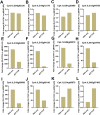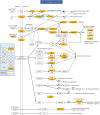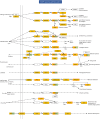Transcriptomic profiling reveals the complex interaction between a bipartite begomovirus and a cucurbitaceous host plant
- PMID: 39294575
- PMCID: PMC11409788
- DOI: 10.1186/s12864-024-10781-6
Transcriptomic profiling reveals the complex interaction between a bipartite begomovirus and a cucurbitaceous host plant
Abstract
Background: Begomoviruses are major constraint in the production of many crops. Upon infection, begomoviruses may substantially modulate plant biological processes. While how monopartite begomoviruses interact with their plant hosts has been investigated extensively, bipartite begomoviruses-plant interactions are understudied. Moreover, as one of the major groups of hosts, cucurbitaceous plants have been seldom examined in the interaction with begomoviruses.
Results: We profiled the zucchini transcriptomic changes induced by a bipartite begomovirus squash leaf curl China virus (SLCCNV). We identified 2275 differentially-expressed genes (DEGs), of which 1310 were upregulated and 965 were downregulated. KEGG enrichment analysis of the DEGs revealed that many pathways related to primary and secondary metabolisms were enriched. qRT-PCR verified the transcriptional changes of twelve selected DEGs induced by SLCCNV infection. Close examination revealed that the expression levels of all the DEGs of the pathway Photosynthesis were downregulated upon SLCCNV infection. Most DEGs in the pathway Plant-pathogen interaction were upregulated, including some positive regulators of plant defenses. Moreover, the majority of DEGs in the MAPK signaling pathway-plant were upregulated.
Conclusion: Our findings indicates that SLCCNV actively interact with its cucurbitaceous plant host by suppressing the conversion of light energy to chemical energy and inducing immune responses. Our study not only provides new insights into the interactions between begomoviruses and host plants, but also adds to our knowledge on virus-plant interactions in general.
Keywords: Cucurbita pepo; Bipartite begomovirus; Plant-virus interaction; Squash leaf curl China virus; Transcriptional reprograming.
© 2024. The Author(s).
Conflict of interest statement
The authors declare no competing interests.
Figures







Similar articles
-
Transcriptional Modulation of Plant Defense Genes by a Bipartite Begomovirus Promotes the Performance of Its Whitefly Vector.Viruses. 2024 Oct 23;16(11):1654. doi: 10.3390/v16111654. Viruses. 2024. PMID: 39599769 Free PMC article.
-
Molecular Characterization and Pathogenicity of Watermelon Isolates of Begomovirus cucurbitachinaense.Int J Mol Sci. 2025 May 1;26(9):4289. doi: 10.3390/ijms26094289. Int J Mol Sci. 2025. PMID: 40362526 Free PMC article.
-
Constant ratio between the genomic components of bipartite begomoviruses during infection and transmission.Virol J. 2023 Aug 21;20(1):186. doi: 10.1186/s12985-023-02148-2. Virol J. 2023. PMID: 37605144 Free PMC article.
-
Signs and symptoms to determine if a patient presenting in primary care or hospital outpatient settings has COVID-19.Cochrane Database Syst Rev. 2022 May 20;5(5):CD013665. doi: 10.1002/14651858.CD013665.pub3. Cochrane Database Syst Rev. 2022. PMID: 35593186 Free PMC article.
-
Factors that influence parents' and informal caregivers' views and practices regarding routine childhood vaccination: a qualitative evidence synthesis.Cochrane Database Syst Rev. 2021 Oct 27;10(10):CD013265. doi: 10.1002/14651858.CD013265.pub2. Cochrane Database Syst Rev. 2021. PMID: 34706066 Free PMC article.
Cited by
-
The Emerging Role of Omics-Based Approaches in Plant Virology.Viruses. 2025 Jul 15;17(7):986. doi: 10.3390/v17070986. Viruses. 2025. PMID: 40733603 Free PMC article. Review.
-
Study of genetic variability and emerging strains of Okra enation leaf curl virus: increasing risks to okra production in India.Physiol Mol Biol Plants. 2025 May;31(5):767-783. doi: 10.1007/s12298-025-01578-2. Epub 2025 Apr 11. Physiol Mol Biol Plants. 2025. PMID: 40568483
References
-
- Tatineni S, Hein GL. Plant viruses of agricultural importance: current and future perspectives of virus disease management strategies. Phytopathol. 2023;113:117–41. - PubMed
-
- Osterbaan LJ, Fuchs M. Dynamic interactions between plant viruses and their hosts for symptom development. J Plant Pathol. 2019;101:885–95.
-
- Ye J, Zhang LL, Zhang X, Wu XJ, Fang RX. Plant defense networks against insect-borne pathogens. Trends Plant Sci. 2021;26(3):272–87. - PubMed
-
- Fiallo-Olivé E, Navas-Castillo J, Begomoviruses. What is the secret(s) of their success? Trends Plant Sci. 2023;28:715–27. - PubMed
MeSH terms
Grants and funding
LinkOut - more resources
Full Text Sources

